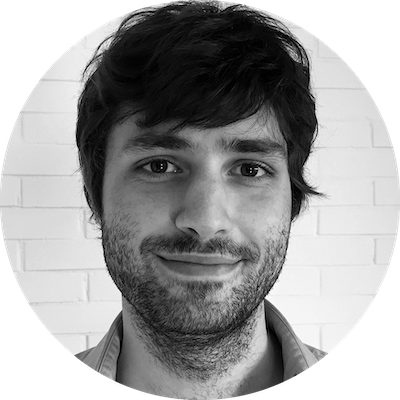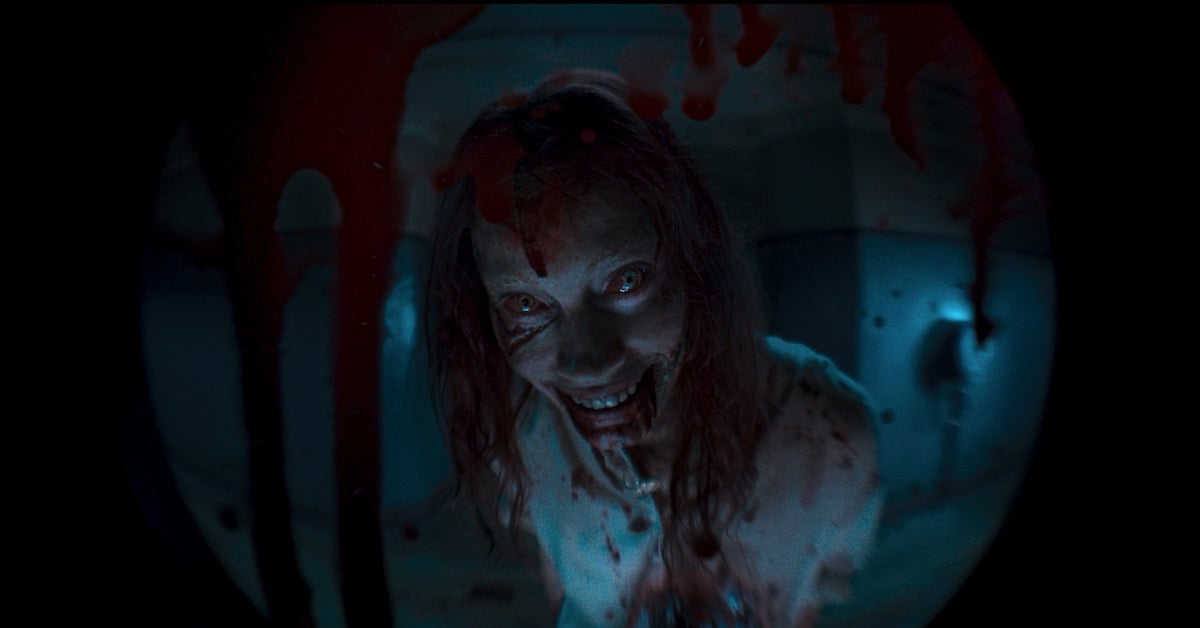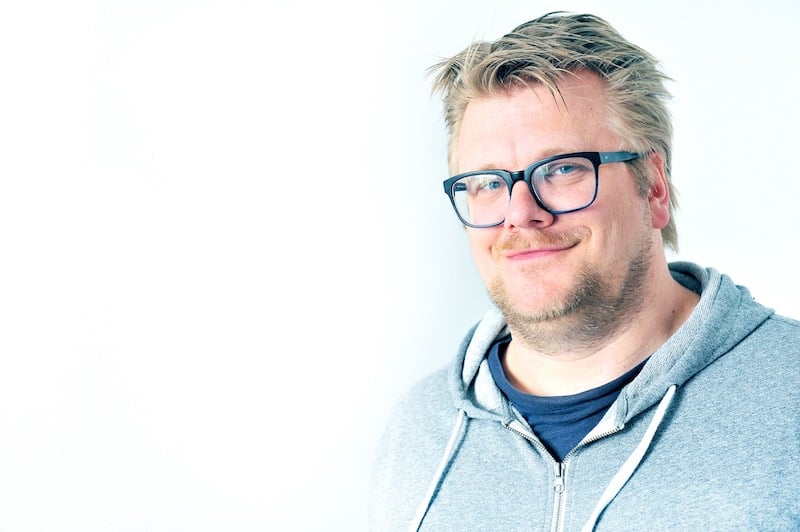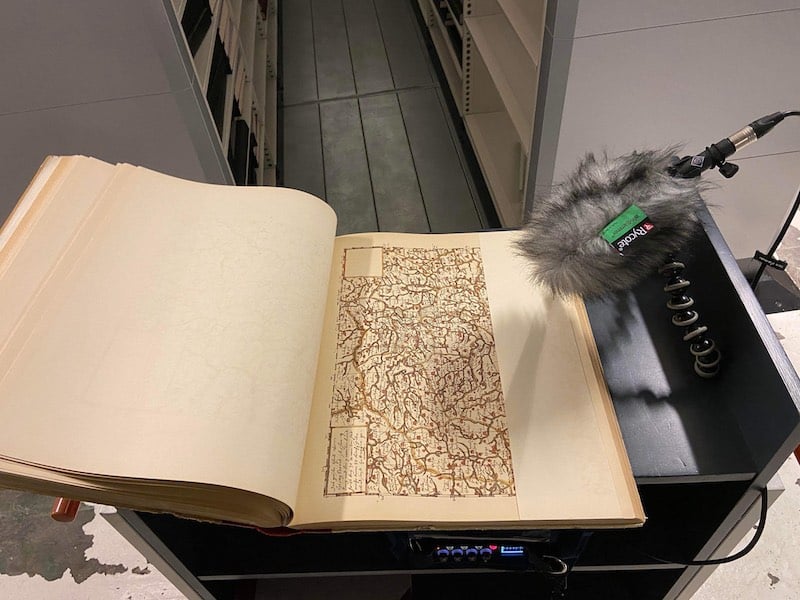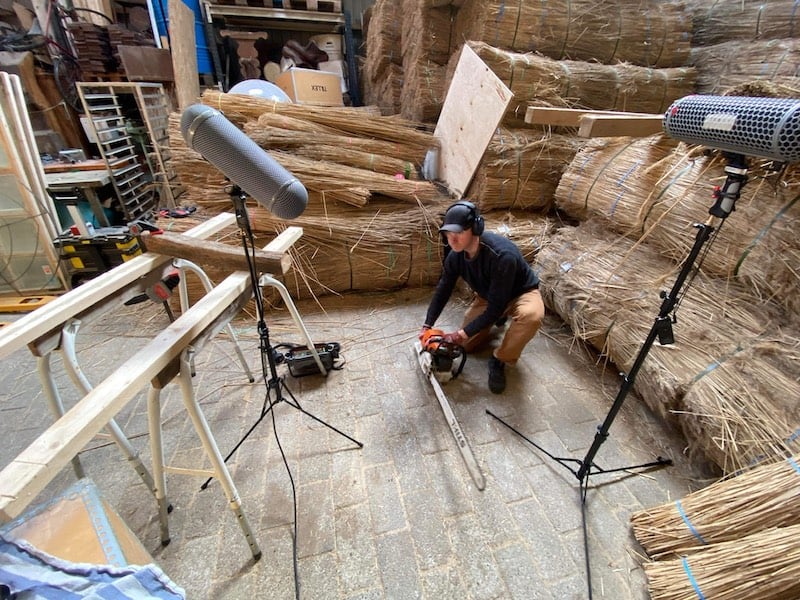Supervising Sound Editor and Sound Designer Peter Albrechtsen dives into crafting the terrifying soundscape of Evil Dead Rise.
In this thrilling interview, we sit down with acclaimed sound artist Peter Albrechtsen (The Cave, The Killing of Two Lovers) as he delves into the process of creating the chilling soundscape for the highly anticipated film Evil Dead Rise. The film takes audiences on a terrifying journey as two estranged sisters battle relentless demonic forces, pushing the boundaries of horror and suspense.
Albrechtsen shares how he embarked on an eight-month creative adventure to explore unique sound recordings for each scene, how he referenced the original films to properly pay homage to the beloved series, and more.
This looks like a childhood dream of a gig. How did you find yourself involved?
Peter Albrechtsen: Lee Cronin, the director, is good friends with an amazing sound designer, Steve Fanagan, who recommended me for this job. When Lee reached out and we started talking, we hit it off immediately because Lee is really passionate about sound. Then I got to read the script and there was so much sound written into the script. It was just an integral part of the story, so it was really evident that it was going to be a really creative adventure.
I worked on it for eight months and I started pretty much as soon as they started picture editing. That was really amazing, cause there's so much sound written into all of the scenes that it was really important to have sounds to be able to do the picture of the scenes. The whole creative collaboration between all of us was really wonderful, getting an idea for something, sending that to the picture editor Bryan Shaw and then to the composer Stephen McKeon. He was also a part of the process this early. To me, that's just the ultimate creative collaboration, when we can all explore the material together and you have the time to do experiments and try things out. Because what often happens when you don't have that much time in post is that you pick the safe solutions because you want to make sure that you are ready for the deadline or that you can do the job in an efficient way. But when you have more time, you can explore a lot of different opportunities, record a lot of sounds. I've never been on a project where we recorded so many unique sounds for the film. Every scene has specific, unique sound effects recordings, and it's pretty amazing.
Supervising Sound Editor and Sound Designer Peter Albrechtsen
If sound is written into the script, then it's like dialogue. You can't cut a film without it.
Exactly. And I think that's also the way Lee is thinking about sound, meaning, some script writers write down dialogue and that's the way that characters communicate. For Lee, a lot of the communication goes on through physical actions and through the sounds that different characters make or that happen around them. So it means that the sound effects in a lot of places are like dialogue in a way.
How did you distribute the workload over those eight months? What took the most time?
I did half of the work in Copenhagen the first three months, then I spent three months in Dublin, and then we were mixing for two months. So in the beginning it was me and my assistant, Mikkel Nielsen, and then I had a dialogue editor, Garret Farrell, who’s from Ireland and came in and helped with some preview mixes and was also mixing the dialogue and the music at the end. The big sound team didn't really come in until the last couple of months. At that point we knew what the basic structure of the whole soundscape of the film was and what I wanted to be done in a more detailed way, so then I had three sound effects editors who helped me out with that. And then we had Caoimhe Doyle, who’s from Ireland, and her Foley team came in at that point and they did a really great job.
Because the script was so elaborate with sound, we started collecting them from the very beginning and the first few months were really all about sound design. There's a lot of demon vocals, so I did a couple of early ADR sessions with actress Alyssa Sutherland, who plays Ellie, the possessed mother, and she was really amazing at doing all these kind weird things with her voice. All the traditional dialogue stuff came much later, so it was really all about designing and creating sound effects that told the story that Lee was looking for that the movie needed.
As wild as the movie is, the sound feels very much grounded in reality. Did you make a conscious effort to achieve that or did you give yourself no limits as to how “design-y” you could get?
Actually, something that I think really connected Lee and I was this idea that we should do this based on organic material. We didn’t want it to be synthesized. Not that the sounds can’t get manipulated, because of course I do all kinds of weird things with them. This is a story about a family falling apart. I've said a couple of times to people that this is the bloodiest family drama you'll ever see, and I think that this being also about human relations meant that we wanted it to be natural and come from the organic world.
We did this during Covid, so a lot was done in lockdown, but the good thing is that because pretty much all the film takes place inside an apartment, a lot of the sound effects that we needed came from everyday objects, but then used in hopefully not very everyday ways, [laughs] but it meant that we could do a lot of sound effects recordings in our own apartments. But of course it wouldn't be an evil dead movie if there wasn't a chainsaw, so we ended up recording several of those. There's a crazy wood chipper that we also recorded, so in that sense there were also a lot of big props to record.
Then we got hold of a really old book from the local library, I think it was around a hundred years old, and recorded these old pages and put those together with some pig skin that we got from the butcher to do the sound for the Book of the Dead, which is such an integral part of the whole Evil Dead Universe.
One of the reference movies that Lee was talking about was The Exorcist, because the demon vocals are all done organically by this old actress who is the voice of the possessed child. There's this Danish singer, Jenny Rossander, who I know from a couple of other projects that I worked on and I just knew that she could do all these crazy voices, so I got her in to do some different voice stuff for scenes where it has to feel like a demon, or for all these beastly sounds, but also for places where, like with the Book of the Dead, you see blood seeping in through the book. That sound is actually the sound of Jenny's throat when she was inhaling breath. We use a lot of those kinds of organic sounds, but then put them in places where you don't expect them to be and then worked with a lot of layering and we mixed in Dolby Atmos, so we could really create a truly enveloping sonic environment.
"We got hold of a really old book from the local library, I think it was around a hundred years old, and recorded these old pages and put those together with some pig skin that we got from the butcher to do the sound for the Book of the Dead, which is such an integral part of the whole Evil Dead Universe."
Recording an old book for The Book of the Dead, with assistant sound designer Mikkel Nielsen.
Was the decision to mix in Atmos there from the beginning and did that inform the process?
Yeah, pretty early. Because of Covid, Warner was thinking of putting the film directly on HBO Max, but Lee and I were from the very beginning saying, “okay, we need to mix this in Atmos and we need to do a big cinematic mix.” We did that because, when we finished the mix, they did a couple of test screenings in LA for an audience and they went crazy. They were euphoric. I mean, apparently they had several minutes of applause after the film. So then Warner decided not to put it directly on HBO Max and to wait about eight months to release it in theaters worldwide.
Do you have a specific approach when you're building your environments in Atmos? The way the little background nuances push you into the screen are to me the most interesting thing about the format.
It was incredibly important to make the film as enveloping as possible. Lee said that he wanted the film to feel epic, even though it was taking place inside an apartment, but he wanted the sound to be so enveloping and so big that you felt like you were totally surrounded, and I totally agree. I mean, we even have doors opening in front of you and then going to the surround speakers. We really used the surround field, and it really feels like being there because it feels like you are enveloped by all the sounds around you.
I really love background sounds, ambience is such a big thing for me and it was something that I mentioned to Lee very early on that I thought should really be a priority for this film. He mentioned Panic Room by David Fincher as a reference because he really liked how in that film, even though we are in the same place during one night like in Evil Dead Rise, it feels like every room has its own signature sound. So that was definitely an inspiration, trying to find signature sounds for every room, but also playing around a lot with how rain and thunder were surrounding you and how much you heard of it. I was playing with textures of thunder and pitching it down a little bit and then moving it around, so even when you have a quiet low rumbling thunder, but it's pitched down even more, then it's almost like something that's moving around the room and you can't really tell what it is, but it…
Makes the scene come alive.
Yes, it makes the scene come alive. It's quite amazing. So we did a lot of subtle things like that, and then spent a lot of time on rain, there’s rain pretty much throughout the film and I played with all kinds of watery elements for this. So I got hold of some of Tim Prebble’s sound libraries. He's done hours and hours of really amazing rain libraries, which I used a lot of, distorting the rain so it became a sinister dark ambience. He also did a library with rhythmic rain sounds and I used the rhythms of the rain to have moments where specific drops hit so that they fit with the lines of dialogue. It's super detailed, but for me it makes even small moments, like a conversation, more intense, more precise and more musical in a way. The thunder was also used both as upfront elements and also as ambient textures, slowing down thunder sounds and running them through different kinds of reverbs, almost turning them into musical elements. So I really spend a lot of time on ambiences.
I thought it was very interesting how you played with that mechanical rumble when Beth shows them the mug. It subtly moves the scene emotionally and avoids the use of an inconsequential music cue.
The moment with the mug is one of several places in the movie where we approach the background sounds very subjectively. In the mug scene we took the sound of a ceiling fan which was already a part of the general room ambience and then used that as a subjective solo element. I really love working creatively with background sounds and this movie was a big playground for that. Lee and I discussed how we wanted the background sounds to reflect how the apartment was falling more and more apart throughout the film so I used all kinds of creaking sounds of floors and pipes and layers of weird electrical noises to get the feeling of the place slowly deteriorating and the electrical installations falling apart. So many different textures.
"Lee and I discussed how we wanted the background sounds to reflect how the apartment was falling more and more apart throughout the film so I used all kinds of creaking sounds of floors and pipes and layers of weird electrical noises to get the feeling of the place slowly deteriorating."
Recording creaks with a homemade creak box.
If there's music, most of the time ambiences are not gonna come through in the mix. Other than Lee, did you also have a discussion with the composer about your intention on focusing on ambiences?
Yeah, Lee loves when sound and music melt together, but also he loves that music is not playing all the time. He really picks every moment to have a significant sound to be there. There shouldn’t be 10,000 sounds happening at the same time, so he wants the soundscape to be very precise and he doesn't like wall to wall music where the music is just playing in the background. If the music is there, it should be because it is saying something. And the same goes for sounds. It shouldn't just be a wash.
If something is there, it should be heard. And if you can't hear it, just get rid of it.
Yeah, exactly. So there's places where we remove the backgrounds completely, then there's a little bit of a drone of music, and then we have some specific pointed sound effects instead. We play around a lot with perspective and constantly shifting back and forth between what we hear. And it was also a big thing with having this big schedule that for many key scenes allowed us to think, “what happens if this sequence is playing with only sound effects? And what happens if it’s only music? What if the music comes in halfway and really takes over? Or what if the sound goes away and the music comes in?” We were able to spend time exploring those things, which meant that we had a really close creative collaboration between music and sound and avoided all these nightmare scenarios where music is just washing away the sound or the other way around. I think what happens when you have music playing all the time is that in the end you don't really notice the music. It just becomes something that's just there playing. Whereas if you really pick your moments, then the music really shines and that's what happens in Evil Dead Rise. I feel like there's these amazing moments like in the opening of the film where there's an amazing reveal of the title card, and it's really all music. It's just Stephen doing an amazing job and it's just so powerful and it gives me shivers each time, and I don't need to bring my sound design in there.
And then there's moments where we don't have music at all and it's just sound and we had this mutual respect. There's also this cheese grater scene that's been talked about a lot. I was like, “here, we need to go crazier than ever before.” And in the film I use a lot of distortion. It was something that me and Garret talked about from there early on, that it would be interesting to really use distortion in this film and play around with that in a creative way. So for that cheese grater moment I distorted the score, I distorted my sounds, but then Stephen came around the day after and I was like, “oh my god, what is he gonna say to this?” And he was so excited. He just really loved it. He was like, “we need to do that even more.” [laughs] So there was this openness, which was just amazing.
Did you get to use some specific tools for this project? Especially for the voices, which I find is something that's very hard to make otherworldly yet organic.
Yeah, we tried to be as organic as possible. Garret Farrell did some really cool stuff with iZotope and Envy. He and I used Envy. I really like this thing where you kind of transform another sound so it fits with a certain source. For example there's this sequence where Ellie is headbutting a door and it's really powerful. I just recorded some really heavy hits on a door and then I tried to use the most impactful sounds that I could think of, so I took train sounds, I recorded some hand grenades, I used some sub harmonic distortion and then I put those through Envy with the hits so that it feels like it's part of the hit. It’s all these massive sounds playing at once and it just gives the headbutts so much power. Envy is an amazing tool to take organic sounds and make them give each other power and a new texture.
This is a beloved franchise and the first movie came out in 1981. Did you get to reference those older movies?
Yeah, one of the first things that happened when I started working on the film was that Bruce Campbell made sure that I got a hard drive with digitized versions of all the sound effects from the first two films. And I mean, not just the actual mixes of the film, but the actual sound effects recordings that they had done. A lot of that was done by Bruce and Sam Raimi together and sometimes also with a sound engineer.
Bruce Campbell as in the lead actor?
Yeah, Bruce Campbell like the old Evil Dead movies were made by Sam Raimi, the director, Rob Tapert, the producer, and Bruce Campbell, who was the star. Bruce and Sam are really into sound, but Bruce is really passionate about it and he made sure that I got the old sounds. So we had all these iconic old Evil Dead sounds. For example, there's this iconic “shot of the force” that's an integral part of all the Evil Dead movies where the camera travels at crazy speed through different environments and that has a sound that apparently is Bruce and Sam making sounds with their mouth. And then they had access to one of the first synthesizers or something, so they kind of synthesized it a little bit. So it has this weird feeling of being organic and synthetic at the same time, but we actually use that sound and then we build on that and put extra sounds on for some of those shots in Evil Dead Rise. There are several sonic references to the old films. There's a certain wind that Sam Raimi recorded in his hotel room, which they're using for the sounds of the cabin in the old Evil Dead movies. We use that for scenes in a vault that is in the beginning of the new film. So it's the same wind there.
Is it kind of an Easter egg for the fans?
Yeah. So if you're a total audio nerd who's also an Evil Dead fan, you'll find a lot of stuff like that. But it's also because we want to build on this amazing, iconic sonic world that they built. But of course, when you make a movie in 2023 and it's the first Evil Dead movie in Atmos and it has to be powerful and have a modern impact, you can't just use old sounds.
"Bruce Campbell and Sam Raimi are really into sound, but Bruce is really passionate about it and he made sure that I got the old sounds. So we had all these iconic old Evil Dead sounds."
Vocal recording with Peter Albrechtsen, Jenny Rossander, Lee Cronin, & Bruce Campbell.
I’m guessing they were not exactly recorded at today’s quality standards. Did you have to process them to not make them stick out?
For the moments in the film where we’re playing them up front, we often layer them with other sounds. A lot of the sounds were quite good, but of course there was noise and it's recorded on old ¼ inch tape, and so on. But, for instance, one of the very first sounds you hear in Evil Dead Rise is the sound of a fly and that exact sound is the first sound you hear in the first Evil Dead movie. Of course it needed a little bit of noise reduction and cleaning, but generally it was fine.
One of the first things that happened was that Bruce came to the studio where I was working in Ireland and he said, “Peter, I'm gonna come around and there are some sounds from the old movies that would be fun to include in the new one, and I can just tell you a few stories about those” and I was thinking he was gonna be in my studio for 15 minutes and then he'll leave. I think he was there for four hours or something, just going through all these sounds. And he's such an entertainer, and he also knows all these stories and he’s actually really passionate about sound, but also very precise. He has a great set of ears and he was there all the way until the final mix.
Were you hands on during the mix?
Garret Farrell mixed the dialogue and music while the effects and foley were mixed by Gabriel Gutiérrez, a brilliant Spanish mixer who mixed a lot of these really great Spanish horror films of the past 10-15 years. I was sitting in the middle saying, “let’s try this” or “let’s try that” with Garret on one side and Gabriel on the other – and Lee was sitting in the back and kind of being the conductor of it all.
You mentioned some pretty out-there panning. Did you have to be mindful of how this would translate on a stereo system or did it work itself out?
We actually did very few changes at the end when we did down mixes. Garret did most of the deliverables, but we had a couple of days at the mix stage at the end to kind of go through the mixes and make sure that this would work. But I think that nowadays the Atmos down mixer is working so well, it's pretty incredible. So even though our mix is super surround, it all folds down really well.
What's your favorite sonic moment in the film?
Oh, there’s quite a lot. One of them you see parts of it in the trailer. It's early in the film. Ellie gets possessed in the bathtub, then gets up and screams and it's like a supersonic scream where everything is rattling and the water in the bathtub is boiling and the scream is so crazy piercing. The electrical systems fail and they crack, and it has all these weird electrical noises throughout the film and it gets more and more crazy throughout. But then I remembered that I had these electromagnetic recordings and I pitched those so that they had the same tonality as the scream. So I bring up more and more of these electromagnetic sounds, which makes it so piercing for the ears, and then it just escalates and escalates until she closes her mouth and stops screaming, and we just take all the sounds out, just go to zero. And then she falls down in the bathtub and then it starts up again. And those kinds of dynamics for me are so important in this film, because it's such an intense film, there's so much happening. So it was really important to take every chance we could to have a little quiet moment, totally silent even, to create these dynamics where you can manage to be in that crazy sonic world for an hour and a half.
"I remembered that I had these electromagnetic recordings and I pitched those so that they had the same tonality as the scream. So I bring up more and more of these electromagnetic sounds, which makes it so piercing for the ears, and then it just escalates and escalates until she closes her mouth and stops screaming."
Recording chainsaw sounds with sound effects editor Thomas Perez-Pape.
I have one last question, if you feel like answering it. You spent almost four months in Ireland. How do you juggle your work life with your personal life?
[Laughs]
Is that the million dollar question?
No, that's a very important question actually. On this one it was hard for sure, because there was a lot of work in other countries. It's hard to make personal life and work like this come together.
Just when I was about to start up on Evil Dead Rise I was in a traffic accident with my kids. My car was totally smashed, my daughter broke her rib and her thumb, my son got a whiplash and I broke both wrists and my sternum. My kids healed very quickly, fortunately, but it was a total shock to all of us and it took me about a month to be able to work properly again. Of course, all my close collaborators on the Evil Dead Rise team heard about it and everybody was incredibly kind and helpful. It meant that from the very beginning of the project, there was a close connection between all of us – as Lee Cronin said: “Family means everything to me.” It felt like we could be very open with each other and that was actually very helpful for the creative process because when you trust each other there’s more room for experimentation and crazy ideas. At the same time, the team really respected that I needed to be with my family as much as possible. I started out working on the project in Copenhagen, where I’m based, and we did the final mix there as well but I also spent a couple of months in Ireland where Lee is based and where the picture editing was happening. And even though working in another country for a couple of months is always hard for the family I was able to fly from Ireland to Denmark each weekend and spent time with my kids. Of course, doing a project of this size takes a lot of family planning and is demanding for everybody. But it worked out well in the end. When we had finished the mix, I bought a new car and the kids were so happy to be driving with me again. That was a beautiful moment.
If possible, somehow, include your family in what you do. When Bruce Campbell was here in Copenhagen for the mix, we went to see the new Dr. Strange film in which he had a cameo and that Sam Raimi directed. So we all went to the cinema and I brought my kids and we were all just sitting there together with Bruce. He was the one with the loudest laugh in the cinema. He thought the whole thing was hilarious. And that was an amazing experience. Just remember to share some great experiences with your family even when times are hard.
Peter, thank you so much. It's always super interesting talking to you. Looks like the movie's doing great, by the way.
It's really amazing. We are over the moon.
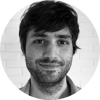 Andreas Russo is a film composer and sound designer. Whether it's field recordings or modular synths, his interest for sound and music comes from their power as storytelling devices and the narrative layers they add to the subtext of a scene. | Instagram
Andreas Russo is a film composer and sound designer. Whether it's field recordings or modular synths, his interest for sound and music comes from their power as storytelling devices and the narrative layers they add to the subtext of a scene. | Instagram


